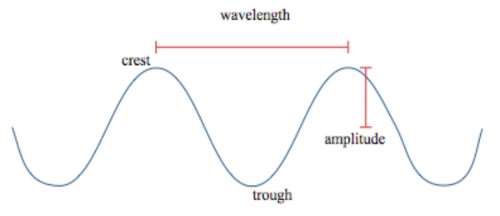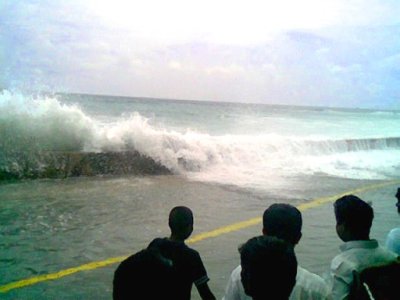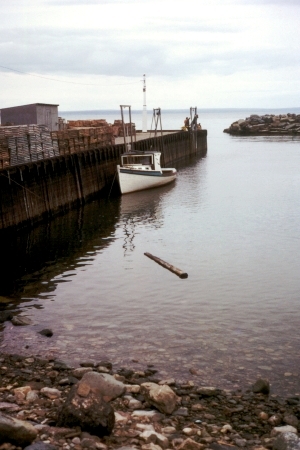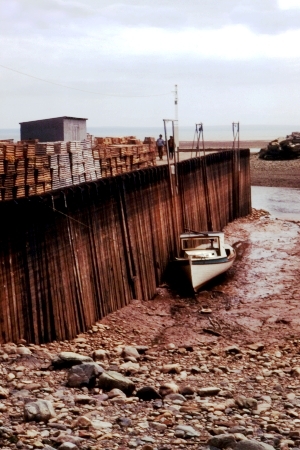High School Earth Science/Ocean Movements
Ocean water is constantly in motion (Figure 14.7). From north to south, east to west, and up and down the shore, ocean water moves all over the world. These movements can be explained as the result of many separate forces, including local conditions of wind, water, the position of the moon and Sun, the rotation of the Earth, and the position of land formations.

Lesson Objectives
[edit | edit source]- Define waves and explain their formation
- Describe what causes tides.
- Describe how surface currents form and how they affect the world's climate.
- Describe the causes of deep currents.
- Relate upwelling areas to their impact on the food chain.
Waves
[edit | edit source]A wave is a disturbance that transfers energy through matter or empty space. Sound waves move through the air, earthquakes send powerful waves through solid earth, spacecraft radio waves travel across millions of miles through the vacuum of empty space, and ocean waves move through water. All of these types of waves are able to transfer energy over great distances. The size of a wave and the distance it travels depends on the amount of energy that the wave carries.
The most familiar waves occur on the ocean's surface. It is upon these waves that surfers play and boogie boarders ride. These waves are mostly created by the wind. There are three factors wind that determine the size of the wave: 1) the speed of the wind, 2) the distance over which the wind has blown, and 3) the length of time that the wind has blown. The greater each of these factors, the bigger the wave.
Waves can be measured by their amplitude, a distance measured vertically from the crest (the top of the wave) to the trough (the bottom of the wave). They can also be measured by their wavelength, which is the horizontal distance between crests (Figure 14.8). When wind blows across the water surface, energy is transferred to the water. The transfer of that energy may create tiny ripples that disappear when the wind dies down, or it may create larger waves that continue until they reach the shore. Most waves reach the shore.


Scientists sometimes describe waves by measuring the speed of a wave. A wave's speed is determined by measuring the time it takes for one wavelength to pass by. Interestingly, particles in the ocean are not significantly moved by waves; although they are bobbled around by the waves, the particles tend to stay where they are.
Waves can also form when a rapid shift in ocean water is caused by underwater earthquakes, landslides, or meteors that hit the ocean. These waves, called tsunami (Figure 14.9), can travel at speeds of 800 kilometers per hour (500 miles per hour). Tsunami have small, often unnoticeable wave heights in the deep ocean. However as a tsunami approaches the continental shelf, wave height increases. The wave speed is also slowed by friction with the shallower ocean floor, which causes the wavelength to decrease, creating a much taller wave. Many people caught in a tsunami have no warning of its approach. Tsunami warning systems are important for protecting for coastal areas and low-lying countries.
Waves break when they get close to the shore. That is due to the wave's interaction with the sea floor. When the wave hits the shore, the energy at the bottom of the wave is transferred to the ocean floor, which slows down the bottom of the wave. The energy at the top of the wave, in the crest, continues at the same speed, however. Since the top of this wave is going faster than the bottom, the crest falls over and crashes down.
Tides
[edit | edit source]Wind is the primary force that causes ocean surface waves, but it does not cause the tides. Tides are the daily changes in the level of the ocean water at any given place. The main factors that causes tides are the gravitational pull of the Moon and the Sun (Figure 14.10).

|

|
| Figure 14.10: High tide (left) and low tide (right) at Bay of Fundy on the Gulf of Maine in North America. The Bay of Fundy has one of the greatest tidal ranges on Earth. | |

How does the Moon affect the oceans? Since the Moon is a relatively large object in space that is very close to the Earth, its gravity actually pulls Earth's water towards it. Wherever the moon is, as it orbits the Earth, there is a high tide 'bulge' that stays lined up with the Moon. The side of the Earth that is furthest from the Moon also has a high tide 'bulge'. This is because the Earth is closer to the moon than the water on its far side. The Moon's gravity pulls more on the planet than the water on the opposite side. These two water bulges on opposite sides of the Earth aligned with the Moon are the high tides. Since ocean water is pulled higher in the areas of the two high tides, there is less water in between the two high tides. These areas are the low tides (Figure 14.11).
The tidal range is the difference between the ocean level at high tide and the ocean at low tide (Figure 14.12). Some places have a greater tidal range than others. High tides occur about twice a day, about every 12 hours and 24 minutes.


The Moon's gravity is mostly responsible for our tides, but the Sun also plays a role (Figure 14.13). The Sun is much larger than our Moon. It has a mass about 27,500,000 times greater than the Moon. A very large object like the Sun would produce tremendous tides if it were as near to Earth as the Moon. However it is so far from the Earth that its effect on the tides is only about half as strong as the Moon's. When both the Sun and Moon are aligned, the effect of each is added together, producing higher than normal tides called spring tides.
Spring tides are tides with the greatest tidal range. Despite their name, spring tides don't just occur in the spring; they occur throughout the year whenever the Moon is in a new-moon or full-moon phase, or about every 14 days.
Neap tides are tides that have the smallest tidal range, and occur when the Earth, the Moon, and the Sun form a 90° angle. They occur exactly halfway between the spring tides, when the Moon is at first or last quarter. This happens because the Moon's high tide occurs in the same place as the Sun's low tide and the Moon's low tide is added to by the Sun's high tide.
Surface Currents
[edit | edit source]Wind that blows over the ocean water creates waves. It also creates surface currents, which are horizontal streams of water that can flow for thousands of kilometers and can reach depths of hundreds of meters. Surface currents are an important factor in the ocean because they are a major factor in determining climate around the globe.
Causes of Surface Currents
[edit | edit source]
Currents on the surface are determined by three major factors: the major overall global wind patterns, the rotation of the Earth, and the shape of ocean basins.
When you blow across a cup of hot chocolate, you create tiny ripples on its surface that continue to move after you've stopped blowing. The ripples in the cup are tiny waves, just like the waves that wind forms on the ocean surface. The movement of hot chocolate throughout the cup forms a stream or current, just as oceanic water moves when wind blows across it.
But what makes the wind start to blow? When sunshine heats up air, the air expands, which means the density of the air decreases and it becomes lighter. Like a balloon, the light warm air floats upward, leaving a slight vacuum below, which pulls in cooler, denser air from the sides. The cooler air coming into the space left by the warm air is wind.
Because the Earth's equator is warmed by the most direct rays of the Sun, air at the equator is hotter than air further north or south. This hotter air rises up at the equator and as colder air moves in to take its place, winds begin to blow and push the ocean into waves and currents.
Wind is not the only factor that affects ocean currents. The 'Coriolis Effect' describes how Earth's rotation steers winds and surface currents (Figure 14.14). The Earth is a sphere that spins on its axis in a counterclockwise direction when seen from the North Pole. The further towards one of the poles you move from the equator, the shorter the distance around the Earth. This means that objects on the equator move faster than objects further from the equator. While wind or an ocean current moves, the Earth is spinning underneath it. As a result, an object moving north or south along the Earth will appear to move in a curve, instead of in a straight line. Wind or water that travels toward the poles from the equator is deflected to the east, while wind or water that travels toward the equator from the poles gets bent to the west. The Coriolis Effect bends the direction of surface currents.
The third major factor that determines the direction of surface currents is the shape of ocean basins (Figure 14.15). When a surface current collides with land, it changes the direction of the currents. Imagine pushing the water in a bathtub towards the end of the tub. When the water reaches the edge, it has to change direction.

Effect on Global Climate
[edit | edit source]Surface currents play a large role in determining climate. These currents bring warm water from the equator to cooler parts of the ocean; they transfer heat energy. Let's take the Gulf Stream as an example; you can find the Gulf Stream in the North Atlantic Ocean in Figure 14.15. The Gulf Stream is an ocean current that transports warm water from the equator past the east coast of North America and across the Atlantic to Europe. The volume of water it transports is more than 25 times that of all of the rivers in the world combined, and the energy it transfers is more than 100 times the world's energy demand. It is about 160 kilometers wide and about a kilometer deep. The Gulf Stream's warm waters give Europe a much warmer climate than other places at the same latitude. If the Gulf Stream were severely disrupted, temperatures would plunge in Europe.
Deep Currents
[edit | edit source]Surface currents occur close to the surface of the ocean and mostly affect the photic zone. Deep within the ocean, equally important currents exist that are called deep currents. These currents are not created by wind, but instead by differences in density of masses of water. Density is the amount of mass in a given volume. For example, if you take two full one liter bottles of liquid, one might weigh more, that is it would have greater mass than the other. Because the bottles are both of equal volume, the liquid in the heavier bottle is denser. If you put the two liquids together, the one with greater density would sink and the one with lower density would rise.
Two major factors determine the density of ocean water: salinity (the amount of salt dissolved in the water) and temperature (Figure 14.16). The more salt that is dissolved in the water, the greater its density will be. Temperature also affects density: the colder the temperature, the greater the density. This is because temperature affects volume but not mass. Colder water takes up less space than warmer water (except when it freezes). So, cold water has greater density than warm water.


More dense water masses will sink towards the ocean floor. Just like convection in air, when denser water sinks, its space is filled by less dense water moving in. This creates convection currents that move enormous amounts of water in the depths of the ocean. Why is the water temperature cooler in some places? Water cools as it moves from the equator to the poles via surface currents. Cooler water is more dense so it begins to sink. As a result, the surface currents and the deep currents are linked. Wind causes surface currents to transport water around the oceans, while density differences cause deep currents to return that water back around the globe (Figure 14.17).
Upwelling
[edit | edit source]As you have seen, water that has greater density usually sinks to the bottom. However, in the right conditions, this process can be reversed. Denser water from the deep ocean can come up to the surface in an upwelling (Figure 14.18). Generally, an upwelling occurs along the coast when wind blows water strongly away from the shore. As the surface water is blown away from the shore, colder water from below comes up to take its place. This is an important process in places like California, South America, South Africa, and the Arabian Sea because the nutrients brought up from the deep ocean water support the growth of plankton which, in turn, supports other members in the ecosystem. Upwelling also takes place along the equator between the North and South Equatorial Currents.

Lesson Summary
[edit | edit source]- Ocean waves are energy traveling through the water.
- The highest portion of a wave is the crest and the lowest is the trough.
- The horizontal distance between two wave crests is the wave's length.
- Most waves in the ocean are wind generated waves. Tsunami are exceptionally long wavelength waves often caused by earthquakes.
- Tides are produced by the gravitational pull of the Moon and Sun on Earth's oceans.
- Spring tides happen at full and new moons, when the Earth, Moon, and Sun are all aligned.
- Neap tides are tides of lower than normal tidal range that occur at first and last quarter moons, when the Moon is at right angles to the Sun.
- Ocean surface currents are produced by major overall patterns of atmospheric circulation, the Coriolis Effect and the shape of each ocean basin.
- Ocean surface circulation brings warm equatorial waters towards the poles and cooler polar water towards the equator.
- Deep ocean circulation is density driven circulation produced by differences in salinity and temperature of water masses.
- Upwelling areas are biologically important areas that form as ocean surface waters are blown away from a shore, causing cold, nutrient rich waters to rise to the surface.
Review Questions
[edit | edit source]- What factors of wind determine the size of a wave?
- Define the crest and trough of a wave.
- Why does a hurricane create big waves?
- Tsunami are sometimes incorrectly called "tidal waves". Explain why this is not an accurate term for tsunami.
- What is the principal cause of the tides?
- What is a tidal range?
- Why do you think that some places have a greater tidal range than other places?
- Which has a greater tidal range, spring tides or neap tides? Explain.
- What is the most significant cause of the surface currents in the ocean?
- How do ocean surface currents affect climate?
- What is the Coriolis Effect?
- Some scientists have hypothesized that if enough ice in Greenland melts, the Gulf Stream might be shut down. Without the Gulf Stream to bring warm water northward, Europe would become much colder. Explain why melting ice in Greenland might affect the Gulf Stream.
- What process can make denser water rise to the top?
- Why are upwelling areas important to marine life?
Vocabulary
[edit | edit source]- amplitude
- The vertical height of a wave, measured from trough to crest.
- Coriolis effect
- The apparent deflection of a moving object like water or air caused by Earth's rotation.
- crest
- The highest point in a wave.
- deep current
- A current deep within the ocean, which moves because of density differences (caused by differences in water temperature and salinity).
- high tide
- The maximum height reached by a tide in the course of a day.
- low tide
- The minimum height reached by a tide in the course of a day.
- neap tide
- A tide that occurs when the Moon, Sun, and Earth are at 90° angles to one another. Tides have the smallest tidal range during a neap tide.
- rip current
- A strong surface current of water that is returning to the ocean from the shore.
- spring tide
- A tide that occurs when the Moon, Sun, and Earth area all in a line. Tides will have the greatest tidal range during a spring tide.
- surface current
- A horizontal movement of ocean water, caused by surface winds.
- tidal range
- The difference between the high and low tide.
- tide
- The daily rise and fall in the level of the ocean water.
- trough
- The lowest point in a wave.
- tsunami
- A seismic sea wave generated by vertical movement of the ocean floor underwater earthquake, underwater volcanic eruption or landslide or meteorite impact.
- upwelling
- Cold, nutrient-rich water that rises from oceanic depths usually near the continents, when wind blows the overlying surface away or along the equator.
- wave
- A change in the shape of water caused by energy moving through the water.
- wavelength
- The horizontal distance between two troughs, or two crests in a wave.
Points to Consider
[edit | edit source]- What is the bottom of the ocean like?
- How is the seafloor studied?
- How does the ocean floor contribute to the ocean's ecosystem?